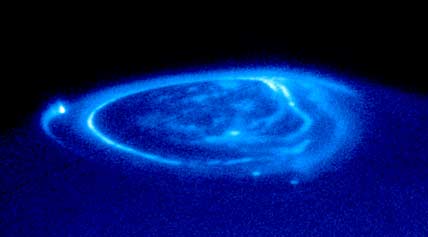
Astronomers may have detected the interaction of an exoplanet's magnetic field with its host star. This Hubble Space Telescope image shows what might be an analogous situation in the solar system: 'footprints' on Jupiter induced by Io, Europa, and Ganymede. The footprints, which appear as bright dots, are embedded in an auroral glow circling Jupiter's north pole. Io's footprint is at the far left, Ganymede's is just below and to the right of center, and Europa's is to the right of Ganymede's. Electric currents generated in the moons flow along Jupiter's magnetic field, producing these markings.
Courtesy NASA/ESA and John Clarke (University of Michigan).
For the first time, astronomers appear to have identified an extrasolar planet with a magnetic personality. The planet orbits HD 179949, a 6.3-magnitude solar-type star (spectral type F8) located 90 light-years away in Sagittarius. After observing the star during three observing runs in 2001–02, a Canadian team led by Evgenya Shkolnik (University of British Columbia) has identified a hot spot that rotates around the star every 3.093 days — exactly the same period with which the planet orbits the star. The hot spot has kept right in step with the planet for more than 100 orbits.
"This is the first glimpse of a magnetic field of an extrasolar planet," said Shkolnik at a Wednesday press conference at the American Astronomical Society meeting in Atlanta. Though the details remain murky, an interaction between the planet's magnetic field and the star's lower atmosphere probably induces the hot spot. The mechanism heats the stellar chromosphere to a temperature about 400 degrees Celsius higher than its surroundings.
The planet was discovered in 2000 by a team led by Chris Tinney (Anglo-Australian Observatory) and R. Paul Butler (Carnegie Institution of Washington). It has a mass at least equal to Jupiter's and orbits HD 179949 every 3.093 days at a distance of only 4 percent the average Earth-Sun distance. Broiling in the star's heat, it belongs to the class of "hot Jupiters" — giant planets that orbit their host stars at amazingly short distances.
Shkolnik's team observed the star with the 3.6-meter Canada-France-Hawaii Telescope on Mauna Kea in Hawaii. Using a high-resolution spectrograph called Gecko, they identified two spectral features of ionized calcium that indicate a region with a higher surface temperature. The calcium features rotate around the star just ahead of the planet and in perfect lockstep with it. In contrast, the star itself rotates once every nine days. However, Shkolnik says there is a 10 percent probability that the synchronization is pure chance.
"I work on spectra a lot, and I wish I had data that were as clean and nice as this," said independent commentator Gibor Basri (University of California, Berkeley). "The observations are leading the way. It's now up to the theorists to explain it."
According to Basri, the magnetic interaction between HD 179949 and its planet is analogous to the magnetic connections between Jupiter and its moons Io, Europa, and Ganymede. Electric currents generated in the moons flow along Jupiter's magnetic field to its cloud tops, forming bright ultraviolet patches near the planet's poles.
The Canadian team observed a total of five stars in hope of seeing magnetic effects. They were motivated by predictions made in 2000 by Manfred Cuntz (University of Texas, Arlington) and Steven Saar (Harvard-Smithsonian Center for Astrophysics) that planetary magnetic fields could produce detectable effects on stars. The team has yet to find hot spots on the four other stars it has studied.
"There is nothing far-fetched at all about this," said Basri. All of the large planets in the solar system have substantial magnetic fields, and Jupiter's field is enormous. It is likely that most or all giant exoplanets possess magnetic fields too.
 0
0
Comments
You must be logged in to post a comment.